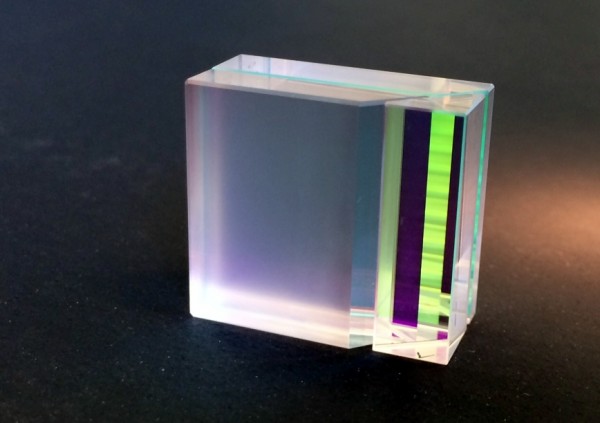
Fused Silica, CaF2; 415-1700 nm, Customer Specified; Finesse 56-~100, Customer Specified; FSR 15-60 GHz, 0.5-2/cm, Customer Specified; Thickness 1.68-6.74 mm, Customer Specified; AR and HR Coating; 22.0x24.0, Customer Specified; Clear Aperture 18x18 mm, Customer Specified
LightMachinery’s OP-6721/OP-7553 series of VIPA (Virtually Imaged Phase Array) etalons are manufactured from Fused Silica (OP-6721) or Calcium Fluoride (OP-7553), allowing operation further into the infrared, IR) using the company’s patented fluid jet polishing (FJP) technology – allowing the adjustment of the etalon’s shape and flatness to within a few nanometers.
Catalog series OP-6721 VIPA etalons are available with dimensions of 22.0 x 24.0 mm and 18 x 18 mm aperture. Free spectral range (FSR) values are 15 GHz (0.5/cm), 30 GHz (1/cm) and 60 GHz (2/cm), each available with nine different finesse values from 56 to 100, resulting in nine different wavelength ranges from 415 to 1700 nm. Wavelength range, thickness, finesse, FSR and other design details of OP-6721 and OP-7553 series VIPAs are also available based on customer requirements.
For the OP-6271 series, a dedicated protective aluminium mount is available that enables mounting the VIPA in a standard 50.8 mm (2”) diameter optic holder – its price includes cementing of the VIPA to the mount at the supplier.
A VIPA (Virtually Imaged Phase Array) is a special type of Fabry-Perot etalon with a built-in transmission window so the beam can sneak in past the first reflector and effectively commence the multiple reflections and constructive and destructive interference from inside the etalon. By changing the first reflector to a full 100% high reflector, the beam can only exit in transmission, this effectively creates an etalon with ~100% transmission.
VIPAs are made with three distinct coatings, carefully selected to match the wavelength range of interest: One surface of a VIPA has an anti-reflection coated section adjacent to a high reflector. The opposite surface is coated with a partially transmitting mirror. Light is introduced into the VIPA at a small angle on the AR coated area. The VIPA is tilted so that the portion reflected from the partial reflector is fully incident on the high reflectance zone of the input surface.
A single input beam is converted to a series of parallel output beams of gradually decreasing intensity. These beams will constructively interfere at an angle that depends on the wavelength. Placing a lens between the VIPA and an array detector (CCD or similar) allows recording of a spectrum of the input light. Each subsequent beam has a precise increase in phase and fixed lateral displacement, hence “phase array”.
LightMachinery is the world leader in high-accuracy VIPA fabrication, and VIPAs are at the core of many of LightMachinery’s spectrometers. Several parameters define the performance of a VIPA. The first is its optical thickness (OPD) – the free spectral range (FSR) is approximately c/OPD. Analogous to a regular etalon, the angular dispersion of the VIPA output will repeat every time the input frequency (or wavelength) increases by 1 FSR.
The second important parameter is the reflectance of the output mirror. In principle, a higher reflectance mirror will increase the resolving power of the VIPA. Light Machinery has optimized the partial reflectivity for each wavelength range to maximize finesse; finesse greater than 100 has been achieved for VIS/NIR applications. In other words, it will be possible to distinguish wavelengths separated by 1/100th of the FSR.
The third important parameter is the internal angle of the light traveling through the VIPA. Smaller angles increase the angular dispersion, and a narrower transition between the antireflection coating and the high reflector enables a smaller angle. LightMachinery’s VIPAs have a transition width of only 2 to 3 µm, which enables operation of the VIPA at a very small angle. This reduction in angle improves resolution and contrast compared to what was previously possible.
Sometimes you need something special – if you are looking for a customized VIPA etalon that exactly meets your specific requirements (e.g. different substrate materials like Silicon, etc.), please get in touch with the AMS Technologies etalon experts. Our supplier LightMachinery is extremely experienced with specifying, designing and manufacturing custom etalons using the company’s patented fluid jet polishing (FJP) technology. We are looking forward to discussing your customized etalon solution!
Fluid jet polishing (FJP) systems use a fine stream of slurry to accurately remove nanometers of material from an optical surface. Many years of refining this computer controlled polishing technology have enabled LightMachinery to use FJP for the adjustment of the shape and flatness of optical components such as etalon mirrors to within a few nanometers as well as the production of very thin components such as wafers and thin etalons that are impossible to accurately polish using conventional technology.
Key Features:
- VIPA (Virtually Imaged Phase Array) Etalons
- Etalon Material: Fused Silica (OP-6721) or Calcium Fluoride (OP-7553)
- Anti-reflective (AR) and High-reflection (HR) Coating
- Wavelength Range: 415 to 1700 nm or Customer Specified
- Finesse: 56 to ~100 or Customer Specified
- Free Spectral Range, FSR: 15, 30, 60 GHz (2/cm, 1/cm, 0.5/cm) or Customer Specified
- Dimensions: 22.0 x 24.0 mm Including a 3 mm Input Window or Customer Specified
- Thickness: 1.68 to 8.74 mm or Customer Specified
- Clear Aperture: 18 x 18 mm or 90% of Outside Dimensions
- Matched Surface Figure: λ/200 rms
- Surface Quality: 10/5 or Better
- Substrate Wedge: <0.05 arcsec
Applications: Spectroscopy; Interferometers; Wavelength Measurement; Lasers; Fine-structural Investigation of Spectral Lines
| Product Group: | VIPA Etalons |
| Manufacturer Series Name: | OP-6721/OP-7553 |
















